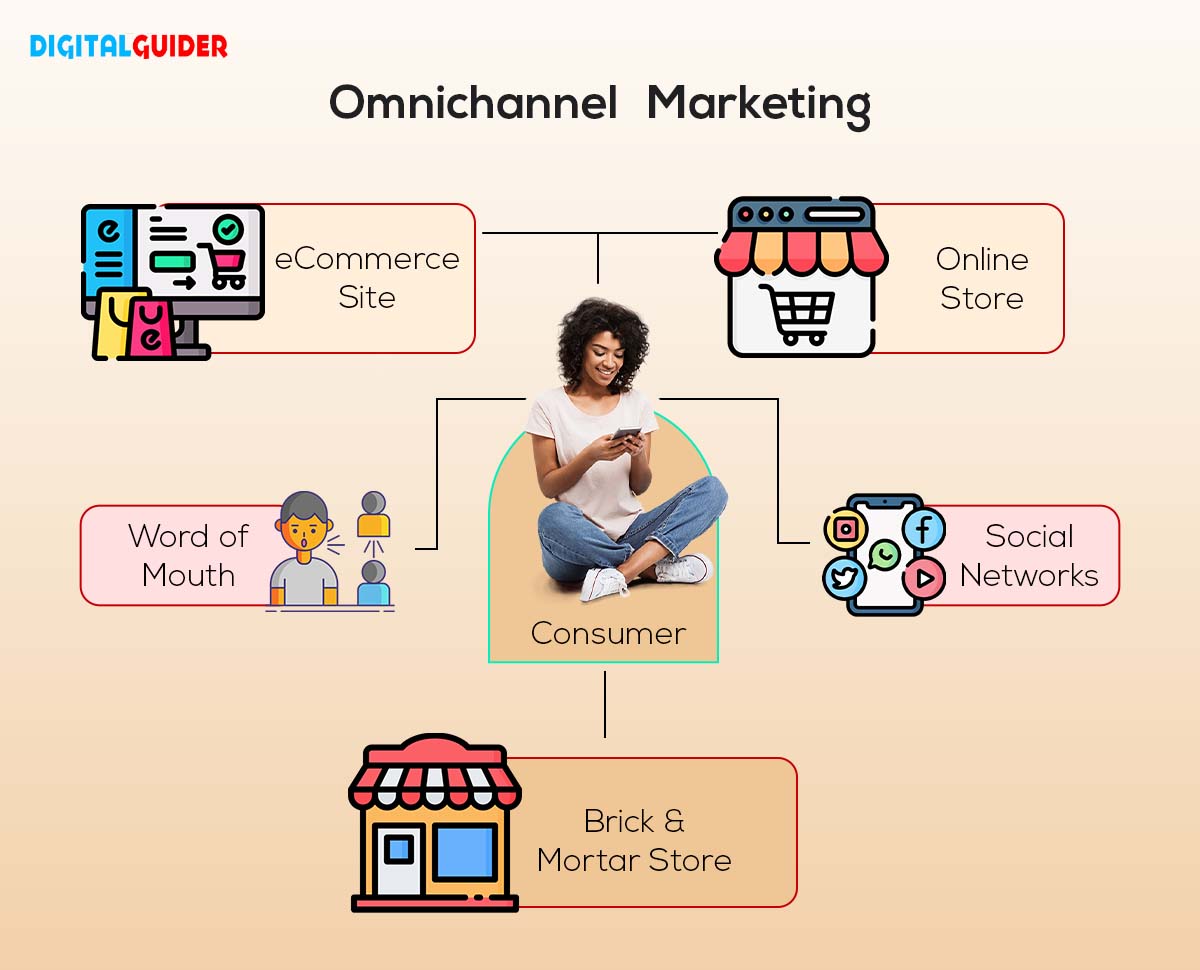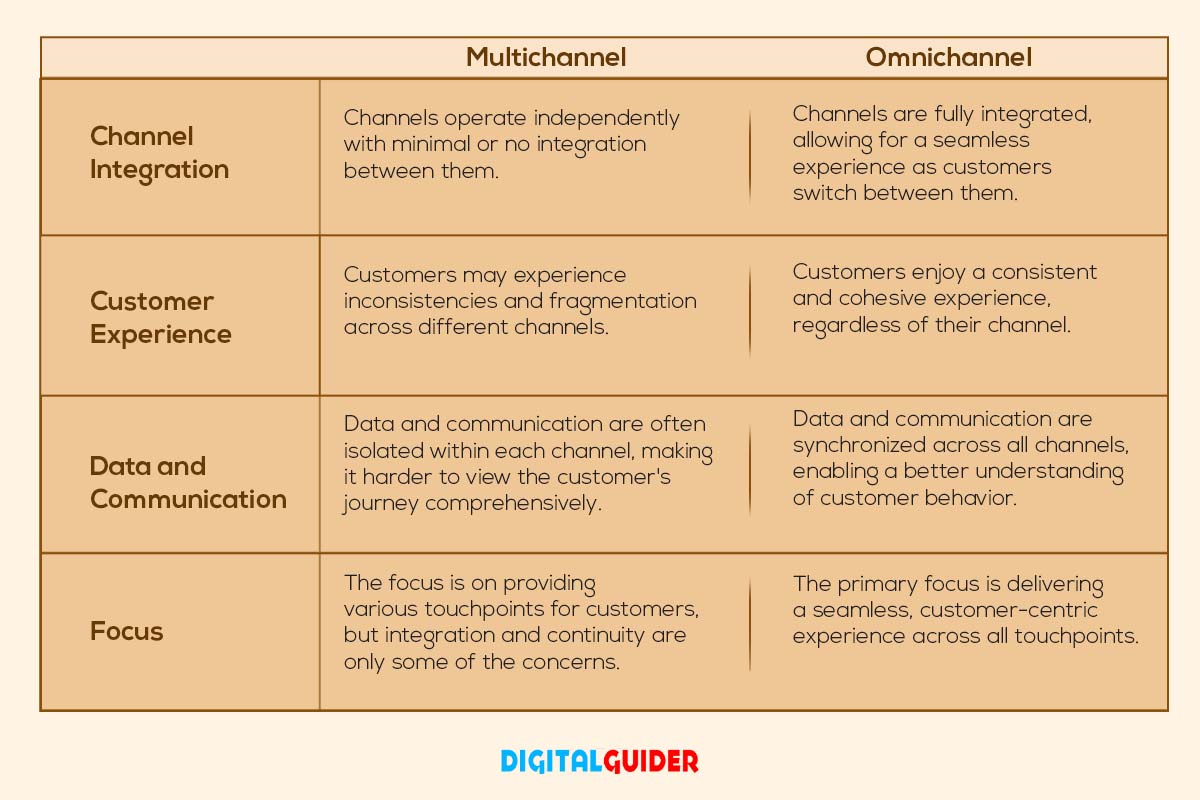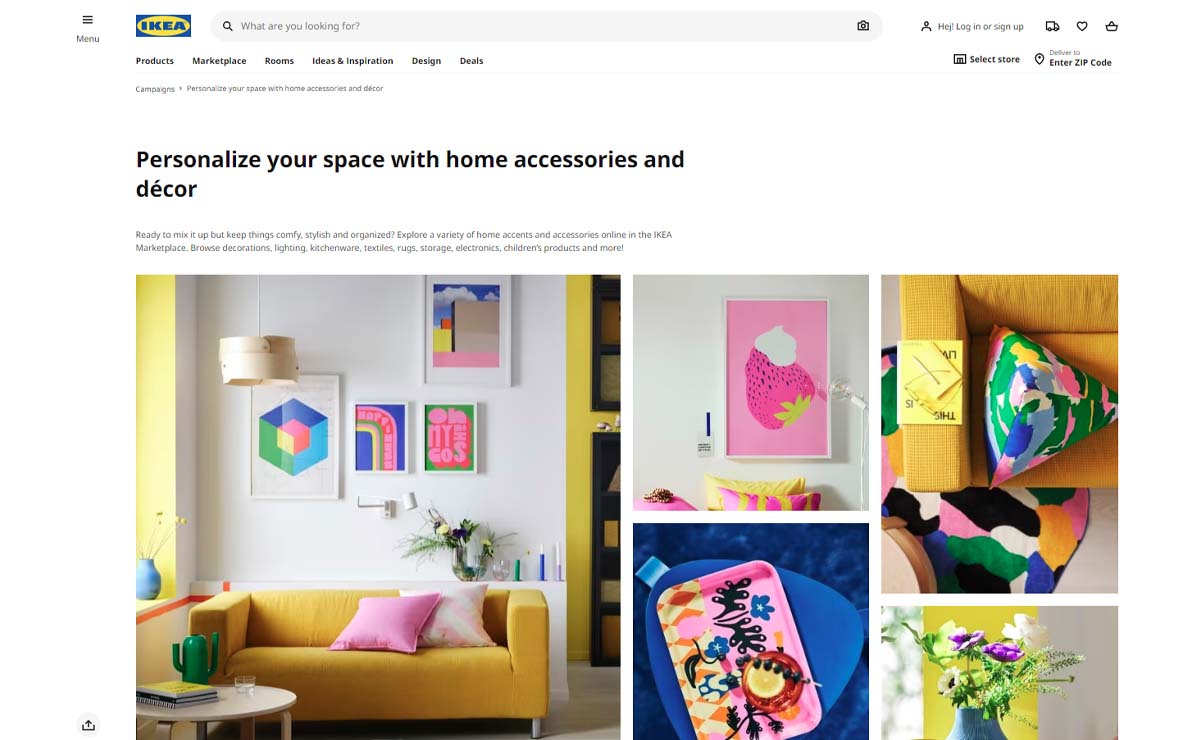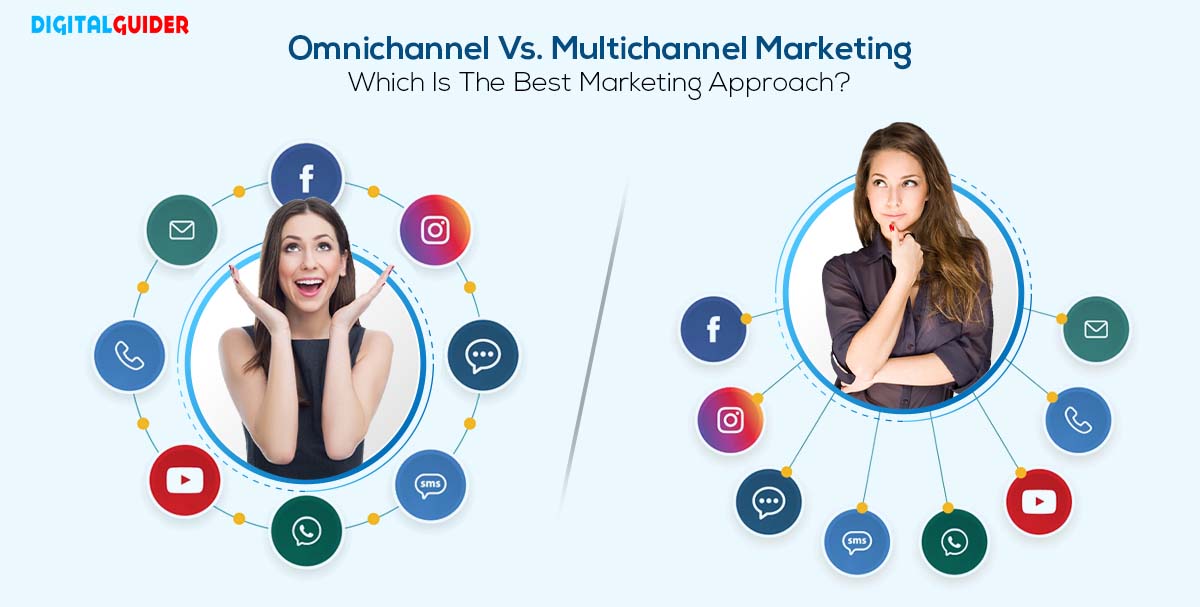Last Updated on December 6, 2023 by Leo Dias
These days, it’s all about ecommerce and social selling. Your customers are everywhere, from social media to emails to texts, and it takes effort to keep up. You need a strong marketing strategy that connects your audience across all channels.
But what’s the difference between multichannel and omnichannel marketing? There is a common myth that both channels are one & the same, which is absolutely incorrect. While multichannel marketing is all about managing each channel separately, omnichannel is more customer-focused, looks at the big picture, and ensures customers have a great experience.
In this blog, we will explore in detail the difference between omnichannel & multichannel marketing channels and which approach will be helpful for your business.
What is Omnichannel Marketing Approach?
Omnichannel is a marketing approach that integrates all channels of your business into a comprehensive customer experience. It encompasses all stages of the customer journey, from the initial stages of the marketing funnel to post-purchase activity. Omnichannel marketing can also be summarized as multiple and interconnected channels.
The channels are interconnected and interactive, which allows maximum customer engagement. At the same time, the channels share customer data and work together seamlessly to deliver a unified user experience across every channel.
What is the importance of Omnichannel Marketing?
The main aim of omnichannel marketing is to remove all hurdles between a customer’s online and offline journey, so a customer can seamlessly continue to finish their buying journey.
Omnichannel marketing allows you to deliver consistent content promotion through messaging simultaneously and campaigns on all channels. Customers will experience a consistent, seamless experience wherever and whenever they engage with your brand.
Let’s understand with an example,
Let’s say you have a furniture store. David is a furniture shopper who found your brand on social media. He clicked on your online store link and added some items to his cart but decided to go to your physical store. He found the same products at the same prices. Later, he got a personal email with a discount for his cart items. He was impressed and made his purchase online. Omnichannel marketing connected his journey and made him a happy customer and brand advocate.
See, instead of losing the lead, the omnichannel approach made the interested customer complete his transaction. Omnichannel is the ability to offer multiple consistent touchpoints to customers. If a customer does not interact with you regularly, your funnel can provide other incentives—or pursue other tactics—to convert more customers.

What is Multichannel Marketing Approach?
Multichannel marketing is an approach that uses multiple inbound marketing channels (e.g., social media, email, physical stores) to reach customers and promote products. Each channel operates independently, aiming to engage diverse customer segments.
With multichannel marketing, engagement occurs at every stage of the customer journey, building relationships between your brand’s channels. These relationships are how your brand connects with your customers. Multichannel campaigns enable each channel to run on its own strategy. This means you can run different promotions across each channel. As a result, cross-channel advertisements tend to be less common — as does consistency across channels.

What is the importance of Multichannel Marketing?
Multichannel marketing lets you focus on the channels driving the most sales. You don’t have to spend all your time and energy on every channel. Whereas omnichannel places the customer experience at the forefront, multichannel places the brand at the forefront. That’s why it’s a popular choice for ecommerce brands who sell on their websites, Amazon, eBay, and other platforms.
Here’s an example of how multichannel marketing works,
Sarah, a new customer, sees your furniture store in a really informative GMB posting with all the cool furniture pieces and a discount you can get in-store or online. She’s hooked and follows your store on social media, seeing all the cute photos of living rooms and bedrooms you’ve decorated with furniture. She wants to check out more options, so she goes to your website and adds furniture to her wish list. The next weekend, she goes to your store and sees in-store displays with the same discount as in the ad.
She signs up for the store’s newsletter and gets a personalized email saying she’s part of the community and giving her a discount for her first purchase. She downloads the app and gets push notifications about the items on her wish list that are on sale. After researching and comparing prices and designs, she buys furniture online and applies the discount from her email.
Multichannel retail engages the consumer in many ways. Websites, social channels, email marketing, traditional mail, retail, and brick-and-mortar stores are just a few examples. Customers expect to interact with a single entity but often engage with each channel individually. They may start shopping in one channel but end up shopping in another.
Also Read: What is Hyperlocal Marketing Strategy – Boost Your Business Locally
Omnichannel Vs. Multichannel- What are the main differences?
Omnichannel and multichannel are two distinct ways businesses communicate with their customers across multiple channels. While they both encompass multiple channels, their implementation and integration level differ significantly.
The main difference between omnichannel and multichannel is the focus of your marketing plan.
Omnichannel marketing is all about the customer and uses all the available media channels.
Multichannel is all about the product and uses multiple channels to promote it.

When it comes to omnichannel marketing, it’s all about the customer. It brings together all the different channels into one seamless shopping experience. It’s tailored to where people are and how people want to engage with your brand. Usually, the promotions are the same or similar, so shoppers get the same deal on all the channels.
Every channel in multichannel marketing is segmented into its own unique experience. Multichannel marketing focuses on the product or service rather than the customer experience. While multichannel strategies encompass multiple channels, they do not contain all channels or devices. The result is a static channel experience rather than an integrated one. As a result, shoppers’ experience on your site will differ significantly from what they experience on your social channels.
Multichannel means you’re investing in multiple channels, but they’re not connected as closely as omnichannel. Omnichannel means all experiences, devices, and media are integrated into one strategy.
On the other hand, omnichannel means you create a smooth experience for shoppers, no matter where they are in their journey.
In a nutshell, omnichannel is all about consistency, and multichannel is about flexibility.
Multichannel Vs. Omnichannel Marketing Example
Multichannel Brand – Nike
Nike is one of the world’s most popular fitness wear brands. It sells its products through various channels, including physical stores, an online store, and mobile apps. It also distributes its products through third-party retailers. While Nike offers customers a variety of ways to buy its products, the channels do not always work together seamlessly.

You can purchase Nike shoes on their official website, Nike app, or at a local Nike store. However, your shopping cart, wish lists, and order history are not synced across all channels.
For example, if you start shopping on the Nike website and later switch to the Nike app, you may find that your cart does not transfer to the app, forcing you to start from the beginning again.
Omnichannel Brand – Starbucks
One of the most successful omnichannel brands is Starbucks. The coffeehouse chain has perfected the art of integrating different channels seamlessly to offer customers a consistent and easy-to-use experience.

With Starbucks, you can order coffee directly from the responsive mobile app and pick it up at your local store. The app also has a loyalty program, where you can earn points for each purchase. Whether you order online, in the store, or through the website, your points accumulate and sync across channels. You can also reload your Starbucks Card within your app or at your local store, and your balance reflects instantly no matter which channel you reload your card from.
Multichannel Brand – IKEA
IKEA is a Swedish furniture retailer that operates in two ways: physical stores and an online e-commerce site.
You can go to a physical IKEA store and browse the furniture and home accessories that the store has to offer. If you decide to buy something, you can pay for it at the checkout counter.

While IKEA does offer an online shopping experience, the online shopping experience may not be completely integrated with your in-store shopping experience. For example, online items may not be the same as those in stock at your physical store, and you may not be able to transfer your browsing history or preferences between the two channels.
Omnichannel Brand – Disney
Disney is one of the most successful omnichannel brands. They offer a smooth experience across all channels, from theme parks to movies to merchandise to digital content.
Customers can buy Disney merchandise at one of their physical Disney Stores, the Disney official website, or the Disney Store application.

No matter what channel the customer is using, the customer’s loyalty program membership, purchase history, and personal preferences are synchronized and recognized.
Another example is Disney’s MagicBands. MagicBands are used in Disney theme parks and are a great example of how a physical product can be connected to the digital experience. Visitors can access rides, purchases, and photo downloads from one wearable device.
Why Should You Choose Omnichannel Marketing?
Omnichannel marketing can be a game-changer for your business if it’s done correctly, whether you’re a small- or large-scale ecommerce marketing team or you’re one of the fastest-growing ecommerce marketers in the world.
There’s no denying that omnichannel marketing takes more time and money to set up and maintain, but it’s worth it.
Here’s a list of questions you must ask yourself to determine if omnichannel is the right fit for your business.
- Is customer experience a top priority for your business?
- Do you have a variety of channels through which customers interact with your brand?
- Can you invest in the necessary technology and infrastructure for integration?
- Are you operating in a competitive market where customer experience is a differentiator?
- Are your customers likely to engage with your brand across multiple digital platforms?
If the answers to these questions suggest that your business is focused on customer experience, has a strong presence across channels, and is willing to invest in integrations and technology, then you’ve come to the right place.
An omnichannel marketing approach can help you create a smooth, customer-focused experience that builds loyalty, improves brand reputation, and helps drive business growth.
Why Should You Choose Multichannel Marketing?
Multichannel can also be a good choice if you don’t have the resources to invest in a complete omnichannel strategy. Because omnichannel marketing takes more time and effort to set up, you may think it’s easy to stay with multichannel because it’s still effective.
The main benefit of multichannel marketing is that it provides flexibility by allowing each channel to operate independently.
Here’s a list of questions you must ask yourself to determine if multichannel is the right fit for your business.
- What is your target audience’s preferred communication method?
- What are your resources and budget constraints?
- Are you in a niche market with limited channel options?
- Are you testing new markets or products?
- Are specific channels known to drive significant sales or engagement for your industry?
- Is your customer base diverse regarding digital literacy and tech adoption?
The choice of multichannel strategy should be based on an in-depth analysis of the target audience, available resources, and the relevant industry environment. Omnichannel marketing is increasingly popular due to its advantages in delivering a smooth customer journey. However, there are still situations where a multi-channel strategy can be effective and suitable.
Wrapping Up
It’s tempting to say that one strategy is better than the other, but it’s not.
The choice between omnichannel and multichannel depends on your business model, resources, customers, and goals.
Omnichannel marketing may necessitate a higher level of investment in technology and coordination. However, its long-term customer retention and loyalty advantages can result in a higher return on investment.
Even if a company has limited resources or is in the initial stages of its customer engagement strategy, multichannel marketing may still be effective.
In conclusion, successful marketing strategies necessitate understanding the target audience, their needs, and the channels they prefer to interact with. By tailoring marketing efforts to customer expectations, businesses can establish meaningful connections and foster business growth, whether they opt for an omnichannel or multichannel approach.







